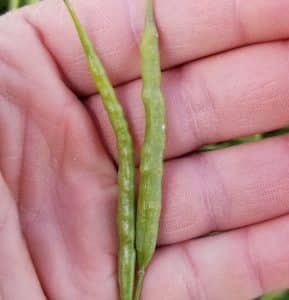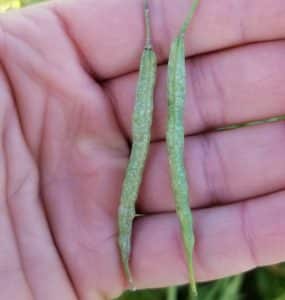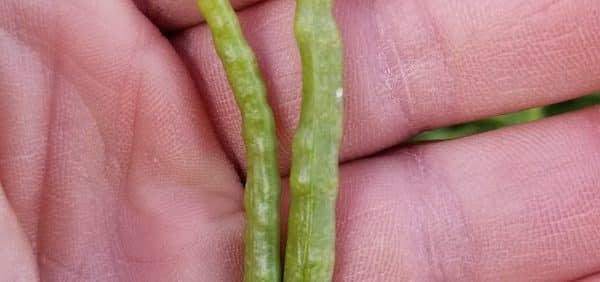Would you choose to swath or straight combine a canola crop…
…when the stand is uneven? With either harvest approach, the least-mature areas of the field need to be left to mature. Swathing remains the best and least risky option to manage extreme variation in maturity, however uneven crops could be left for straight combining. While early maturing plants may start to shell out, late maturing plants have more time to mature. This eliminates the need to make the swath timing decision at all. If using pre-harvest glyphosate in this situation, remember that it must applied after the crop is at 30% seed moisture, or less. If a large percentage of plants have not reached this stage, it can result in elevated glyphosate levels in the seed. What to do with uneven fields.
…when the crop is lodged? Swathing has no clear advantage over straight combining for lodged canola. It often comes down to personal preference, but the following questions can help with your decision.
…after a heavy frost? Pod splitting or pod drop due to tissue damage from the heavy frost usually starts within a day after the frost event. If the canola crop is still sound, growers can probably stick with original plan to straight combine.
If frost damage is fairly heavy, getting brittle plants into a swath could protect them from wind whipping, which could increase losses in standing canola. However, swathing means you handle these brittle crops twice. The act of swathing may create just as many losses as leaving the field standing.
Here are a couple thoughts to consider while making this decision:
- Would you sleep better if the crop was swathed? If yes, swathing is probably the best decision.
- What is the state of seed in the most frost damaged pods? If frost hit top immature seeds hardest, these will shrivel up and won’t contribute much to yield anyway. If frost damage was minimal to those lower pods that will contribute more to yield, you may be able to leave the crop standing – if that was your original plan – without significant losses to these pods.
- Will pod shatter tolerant varieties reduce pod shatter after a frost? This may be worth a conversation with the seed provider.
- Will crop swathed that late make a nice tight windrow? Plants at that stage of maturity are lighter and stiffer and may not pack down into a windrow that will protect them from wind.
If you’re still torn, swath part of the field, leave the rest, and do a comparison. That experience might help the next time you encounter this situation. Read the full article on frost.


…when you want to combine sooner? Swathed canola can be ready to combine earlier than standing canola, but swathing early does not necessarily mean combining early. Canola swathed green takes a lot longer to cure than canola swathed at 60 per cent seed colour change, and by cutting early, the crop may not meet its yield and quality potential. For canola left standing for straight combining, desiccants (diquat/Reglone) will not speed-up crop maturity, but they can speed up crop dry-down and make it possible to get into the field sooner.
Note the important distinction: There is a big difference between maturity and dry-down. Desiccants like diquat shut down the plant and basically STOP it from maturing, which can lock in high green seed levels and end the finishing opportunity for latest seeds if applied prematurely.
